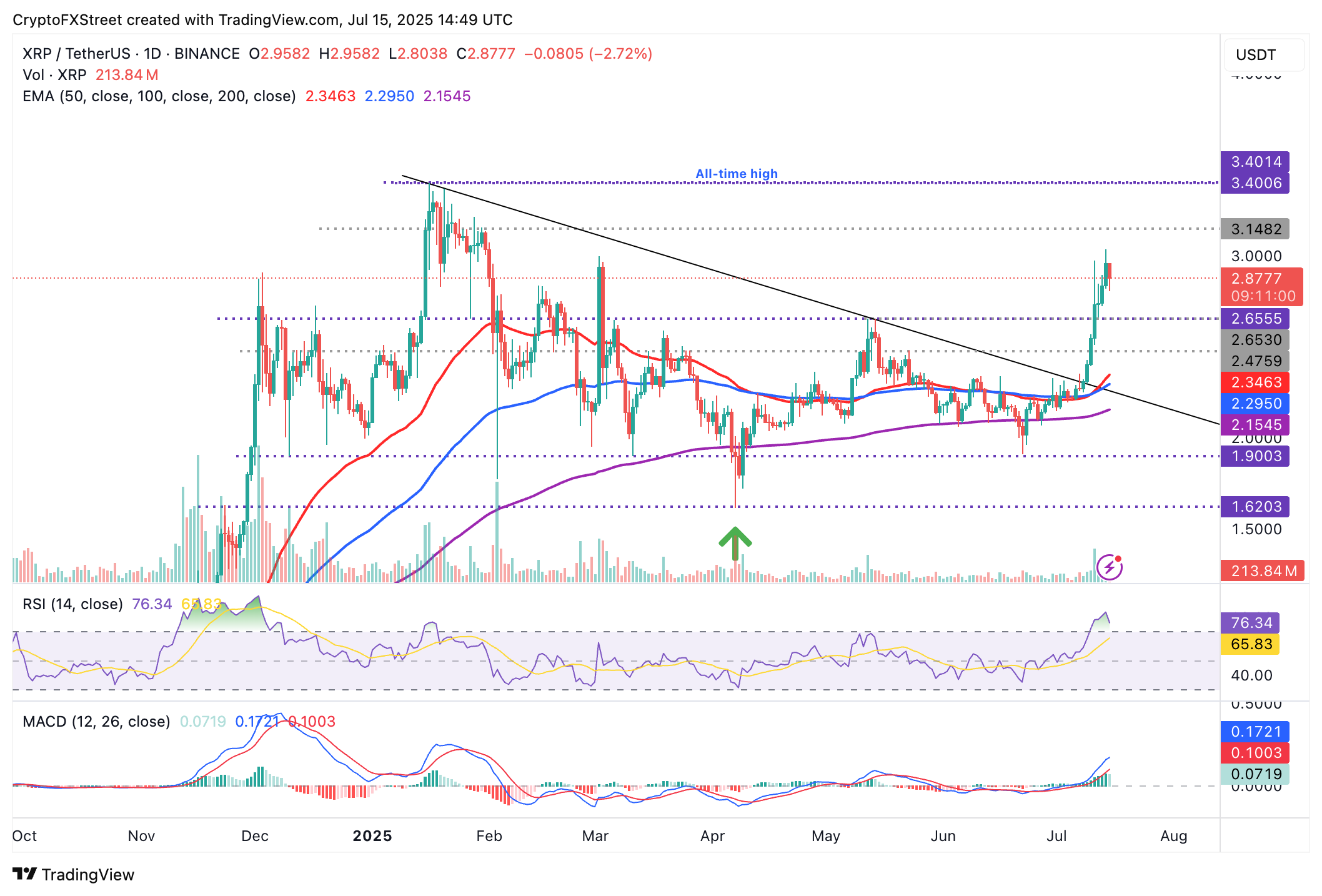Ripple Price Forecast: XRP uptrend cools amid 'Crypto Week' and rising US inflation
- XRP bulls rush to defend support at $2.80 after a volatility spike in the broader cryptocurrency market on Tuesday.
- US CPI data shows that inflation rose 2.7% in June, reflecting the impact of higher tariffs amid economic uncertainty.
- US 'Crypto Week' is ongoing, with the House expected to vote on various cryptocurrency regulations, including the GENIUS Act.
Ripple (XRP) slips below $3.00 on Tuesday, exchanging hands at $2.87. The decline follows XRP's rally, which reached a weekly high of $3.03 on Monday, reflecting the soaring volatility in the broader cryptocurrency market.
Most crypto assets in the top 100 by market capitalization followed in Bitcoin's (BTC) footsteps, edging higher amid rising investor appetite. Bitcoin reached a new all-time high above $123,000 before experiencing a sharp correction, signaling heightened profit-taking as investors booked profits.
Market overview: XRP uptrend stalls as US inflation rises
Investors turned their attention to the release of the United States (US) Consumer Price Index (CPI) data on Tuesday, which created instability across the crypto market. According to the US Bureau of Labor Statistics (LBS), the annual inflation rate rose 2.7% in June, an increase from 2.4% in May, while matching market expectations.
The core Consumer Price Index, which excludes the volatile prices of food and energy, rose 2.9% in June, up from 2.8% the previous month. On a month-over-month basis, the headline CPI and core CPI increased 0.3% and 0.2%, respectively.
Cryptocurrency prices remained relatively stable following the release of the US CPI data, indicating that the volatility shock had been factored into the market. XRP shows signs of resuming its uptrend after rebounding from the support level at $2.80.
US 'Crypto Week' could boost interest in XRP
The US House of Representatives announced the 'Crypto Week' on July 3, which kicked off on Monday, during which lawmakers will consider various cryptocurrency-related bills, including "the CLARITY Act, the Anti-CBDC Surveillance State Act, and the Senate's GENIUS Act."
The House Committee on Financial Services Chairman French Hill said that this would be a monumental week as the US takes steps toward becoming the "crypto capital of the world." The landmark legislation aims to establish a clear regulatory framework for digital assets that protects the interests of consumers and investors while also fostering guidelines for the issuance of stablecoins. As part of the House mandate, lawmakers will also permanently block the establishment of a Central Bank Digital Currency (CBDC), ensuring that the financial privacy of the American people is safeguarded.
"Passing stablecoin and market structure legislation, alongside a CBDC ban, will ensure the US wins the Web3 race," House Representative Bryan Steil said.
Ripple is among the companies that could immediately benefit from the passing of the three bills, particularly with the GENIUS Act and the CLARITY Act. RLUSD is Ripple's regulated US Dollar (USD) backed stablecoin. At the same time, with clear regulations, Ripple could advance its Ripple Payments platform, increasing adoption and demand for XRP.
Technical outlook: XRP bulls fight to resume the uptrend
XRP price faced increasing selling pressure during the early American session amid the risk of extending the decline toward the 50-day Exponential Moving Average (EMA), which is currently at $2.34 at the time of writing.
The Relative Strength Index (RSI) is currently moving downward, at 77 on the daily chart, signaling bearish momentum. Traders could reduce exposure if the RSI slips into neutral territory, potentially accelerating the trend reversal.
If volatility persists due to the perceived risk of rising inflation in the US, investors may focus on de-risking, thereby maintaining the path of least resistance downward. Other key areas that could serve as support include May's peak at $2.65 and $2.47, which capped price action in late March.

XRP/USDT daily chart
Still, the Moving Average Convergence Divergence (MACD) indicator, which has maintained a buy signal since June 28, suggests that XRP has the potential to resume its uptrend. However, this would depend on the investor's risk appetite and the market dynamics surrounding the implementation of higher tariffs on imports into the US on August 1.
Cryptocurrency metrics FAQs
The developer or creator of each cryptocurrency decides on the total number of tokens that can be minted or issued. Only a certain number of these assets can be minted by mining, staking or other mechanisms. This is defined by the algorithm of the underlying blockchain technology. On the other hand, circulating supply can also be decreased via actions such as burning tokens, or mistakenly sending assets to addresses of other incompatible blockchains.
Market capitalization is the result of multiplying the circulating supply of a certain asset by the asset’s current market value.
Trading volume refers to the total number of tokens for a specific asset that has been transacted or exchanged between buyers and sellers within set trading hours, for example, 24 hours. It is used to gauge market sentiment, this metric combines all volumes on centralized exchanges and decentralized exchanges. Increasing trading volume often denotes the demand for a certain asset as more people are buying and selling the cryptocurrency.
Funding rates are a concept designed to encourage traders to take positions and ensure perpetual contract prices match spot markets. It defines a mechanism by exchanges to ensure that future prices and index prices periodic payments regularly converge. When the funding rate is positive, the price of the perpetual contract is higher than the mark price. This means traders who are bullish and have opened long positions pay traders who are in short positions. On the other hand, a negative funding rate means perpetual prices are below the mark price, and hence traders with short positions pay traders who have opened long positions.

